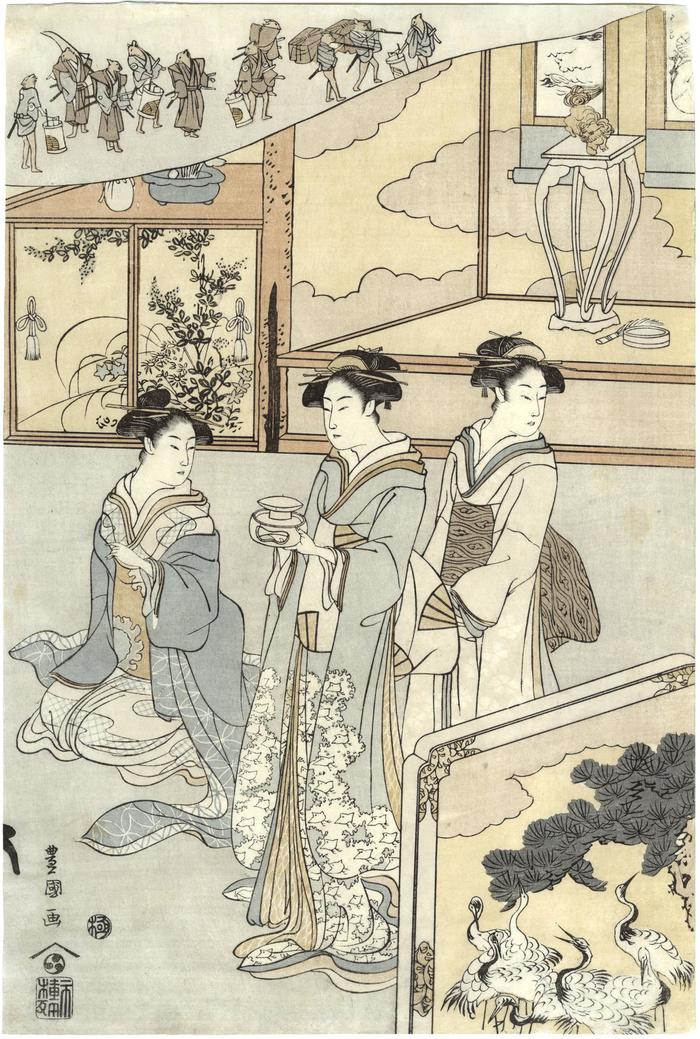Utagawa Toyokuni I (初代歌川豊国) (artist 1769 – 02/24/1825)
A Lucky New Year Dream of a Mouse Wedding (鼠の嫁入りの初夢)
ca 1792
9.75 in x 14.5 in (Overall dimensions) Japanese woodblock print
Signed: Toyokuni ga 豊国画
Publisher: Nishimuraya Yohachi (Marks 391 seal: 1-008)
Censor's seal: kiwame
Museum of Fine Arts, Boston - an original edition of the whole triptych
Museum of Fine Arts, Boston - another original edition of the whole triptych
Musées Royaux d'Art et d'Histoire, Brussels
Ritsumeikan University - a page, in Japanese, devoted to the theme of the triptych
Art Institute of Chicago - another original edition of the whole triptych
New York Public Library - an original copy of this print - they have the full tritptych
Laura Nuffer in her 2014 doctoral dissertation, 'Of Mice and Maidens: Ideologies of Interspecies Romance in Late Medieval and Early Modern Japan', from the University of Pennsylvania wrote about mouse marriages.
****
This example almost certainly is a later printing from re-carved blocks.
****
There is a copy of the middle panel of the triptych in the collection of Anne van Biema collection of which the late edition print in the Lyon Collection represents the right-hand part. Julie Nelson Davis in her entry on page 282 for that van Biema print in Masterful Illusions... speculated that it came from a triptych, which we now know to be true. She wrote: "This print depicts four figures from the Yoshiwara, the licensed pleasure district in the northeastern quadrant of the city of Edo. It is likely the central panel from a triptych... "
"The girls are enjoying Hyakunin Isshu (one hundred poets, one poem each), a game traditionally played on New Year's Day, while the maid reads a yellow-backed novelette (of the type Toyokuni and other ukiyo-e artists often illustrated). The shinzō dreams of a procession of mice dressed in human clothing to resemble bearers, gentlemen, and ladies-in-waiting; perhaps she is dreaming of the story The Mouse's Wedding (Nezumi no yomeiri [鼠の嫁入])."
****
At Ritsumeikan University online is a page devoted to the full composition. It says, in a Google generated English translation: " "The Mouse Wedding" is an ancient fable that appears in the Kamakura period Buddhist tale collection "Shasekishu [沙石集 - 'Sand and Pebbles']." One theory is that mice get married on the night of New Year's Eve, and are often depicted in New Year prints as messengers of Daikoku-sama that bring good fortune in the new year. Also, women can be seen playing karuta from the left side of the work to the center. The cards are scattered randomly face up, and from the presence of the woman waiting to pick them up and the reader, it is speculated that they are being played in a similar way to Genji Karuta or Hyakunin Isshu Karuta."
****
The Shasekishu was compiled by Mujū Ichien (無住一円: 1226/7-1312) and included 'The Mouse Wedding'. It was meant to be an instructive tale or setsuwa (説話).
****
Illustrated:
1) in Marching Through the Floating World: Processions in Ukiyo-e Prints, Rhode Island School of Design, 2020, page 107. It shows the full triptych.
2) in color, the full triptych, in Japanische Holzschnitte aus dem Nationalmuseum in Krakau, Edition Cantz, 1990, number 73, pages 100-101.
Nishimuraya Yohachi (西村屋与八) (publisher)
beautiful woman picture (bijin-ga - 美人画) (genre)
